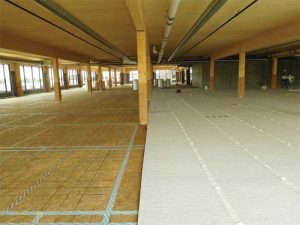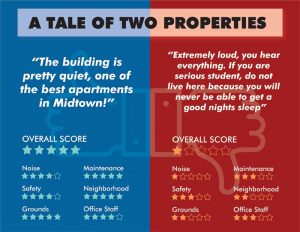by Evelyn Way

As new construction techniques and certifications become more widely used, specifiers must be aware of the many factors impacting the transmission of sound in buildings. It is important to take sound isolation into consideration when designing multifamily residential buildings to ensure the long-term comfort and satisfaction of building occupants.
Online ratings offer a glimpse into the subjective experience of noise in multifamily residences (Figure 1). A 2019, one-star, “not recommended” review from apartmentratings.com says: “Extremely loud…Super thin wall…Constant banging and slamming sounds,” while another five-star, “recommended” review gushes: “One of the best apartments in Midtown…the building is pretty quiet.”
The influence of the acoustic environment on the overall occupant satisfaction is objectively borne out in an analysis of the 2005 American Housing Survey, which found “the most dramatic impact on residential satisfaction comes from hearing neighbors through the floors, walls, or ceiling.” Noise was a more important factor in satisfaction rating than other physical amenities such as fireplaces, dishwashers, or disposals. Further, resident satisfaction is closely correlated with increased turnover and vacancy rates (refer to “Multifamily Housing Characteristics and Tenant Satisfaction” by R. James). Focusing on acoustic comfort in building construction not only improves the perceived quality of the space, but is also necessary to meet code requirements and improve workplace productivity.
The above-mentioned negative review provides feedback related to the two methods of sound transfer in buildings:
- airborne (“super thin wall”); and
- structure-borne (“banging and slamming”).

Airborne sounds, such as voices, televisions, telephones ringing, or dogs barking, are transmitted through the partitions and re-radiated on the other side. Impact sounds, such as hard-soled shoes, dropped objects, or animal toenails, transmit directly into the structure and are radiated as sound through the ceiling. These different sound transmission mechanisms require accurate assessments of varied objective measures.
ASTM defines single-number metrics for testing of airborne sound transmission class (STC) and impact isolation class (IIC). For the standardized measurements, STC uses a broadband airborne sound source (loudspeaker), and the sound level in the source room is compared to the level in the receiving room across a range of audible frequencies. The impact measurement method for IIC uses a calibrated tapping machine as the sound source. The tapping machine drops standardized metal weights at the rate of 10 times per second. Since the IIC test uses a standardized sound source, only the level in the receiving room is recorded. For both metrics, the resulting levels are compared to a set of pre-determined curves to calculate the single-number result (Figure 2). Lab conditions are carefully controlled so the sound transmission measured is only due to the test sample under consideration.
Since STC and IIC both are assessed in ideal laboratory conditions, additional metrics have been developed for field use. While test procedures are the same as in the lab, and a quiet environment free from intrusive sounds is necessary, field and lab results are evaluated differently because the partition being tested cannot be separated from the rest of the building. Flanking paths will contribute to the sound and vibration transferred from one room to another. Since more sound is expected to be transmitted in field conditions, the lab measurement is typically three to five points higher than a field measurement of the same construction assembly. The most commonly used field metrics—apparent sound transmission class (ASTC) and apparent impact isolation class (AIIC)—normalize the results based on the finishes in the receiving room. ASTC and AIIC were formerly referred to as field sound transmission class (FSTC) and field impact isolation class (FIIC).




